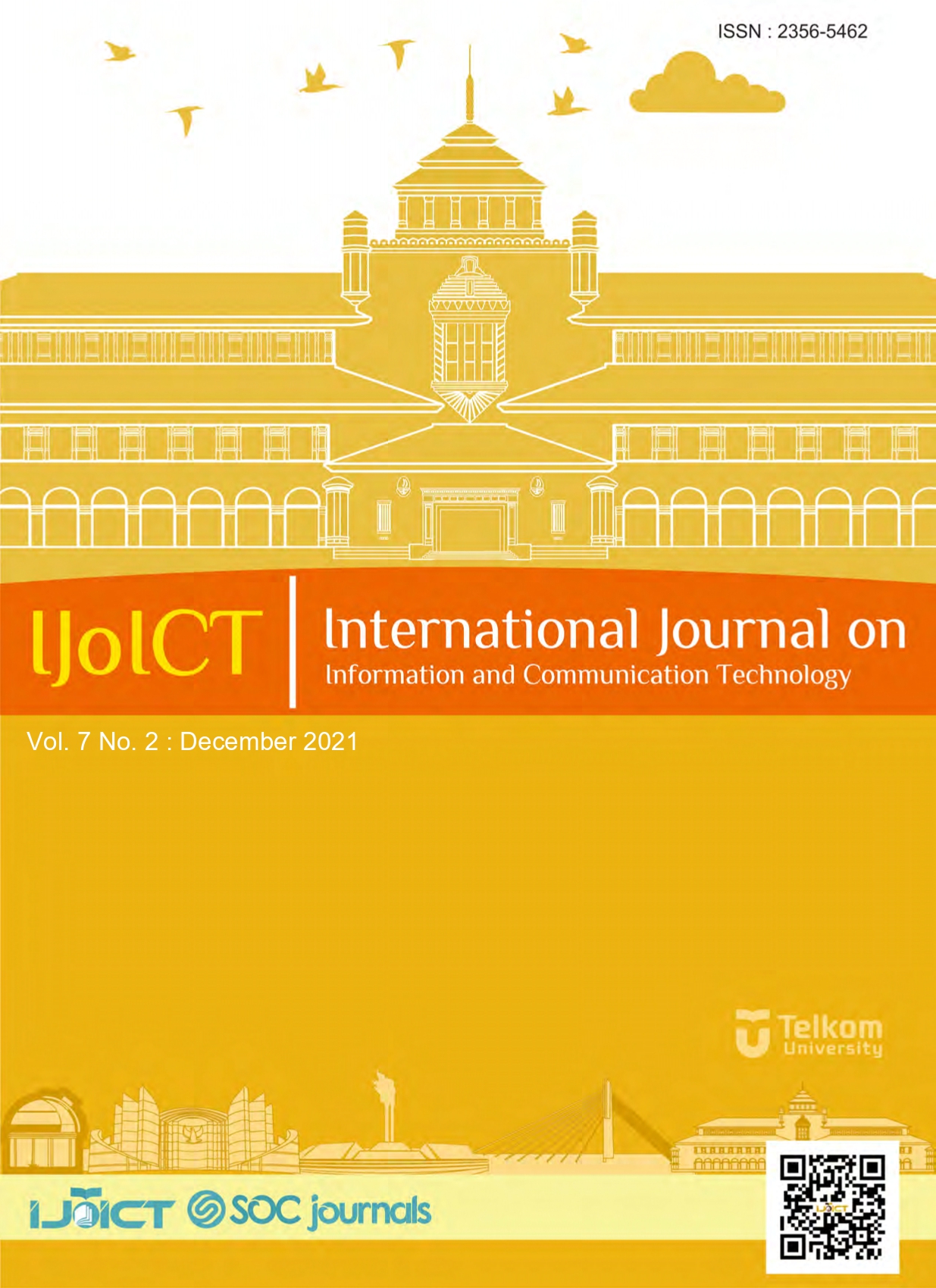The Effect of Number of Factors and Data on Monthly Weather Classification Performance Using Artificial Neural Networks
DOI:
https://doi.org/10.21108/ijoict.v7i2.602Keywords:
backpropagation, artificial neural networks, predictions, monthly weather, rainfallAbstract
Current weather-related research only focuses on weather prediction based on raw data and the factors used are generally 4 factors: average temperature, solar radiation, air pressure, and wind. In this research, monthly weather prediction is done using 5 factors where the additional factor used is rainfall in the previous time. In contrast to previous prediction research, the prediction process carried out in this study emphasizes the modeling of training data according to the desired prediction model.. These two things distinguish this research from previous studies. The prediction model used in this study is a classification-based prediction model that is the Artificial Neural Network (ANN) method combined with the backpropagation algorithm for calculating the weight of the ANN network. The data used are meteorological data from 2010 to 2018 in the Bogor area, where data from 2010 to 2016 are used as training data, and data from 2017 to 2018 are used as test data. The results of this study indicate that the design of the model with the use of data for 6 years with feature data of 5 factors has an accuracy rate of 83.33%.
Downloads
References
Julismin, “Dampak Dan Perubahan Iklim Di Indonesia,†J. Geogr., vol. 5, no. no.1, pp. 39–46, 2013.
O. C. P. Pradana and R. N. Sesanti, “ANALISIS DAMPAK PERUBAHAN IKLIM TERHADAP CURAH HUJAN BERDASARKAN PERUBAHAN ZONA AGROKLIMATOLOGI PADA SKALA LOKAL POLITEKNIK NEGERI LAMPUNG,†J. Wacana Pertan., vol. 14, no. 1, 2018, doi: http://dx.doi.org/10.37694/jwp.v14i1.23.
F. Sheikh, S. Karthick, D. Malathi, J. S. Sudarsan, and C. Arun, “Analysis of Data Mining Techniques for Weather Prediction,†Indian J. Sci. Technol., vol. 9, doi: 10.17485/ijst/2016/v9i38/101962.
D. Susilokarti, S. S. Arif, S. Susanto, and L. Sutiarso, “IDENTIFIKASI PERUBAHAN IKLIM BERDASARKAN DATA CURAH HUJAN DI WILAYAH SELATAN JATILUHUR KABUPATEN SUBANG, JAWA BARAT (Identification of Climate Change Based on Rainfall Data in Southern Part of Jatiluhur, Subang District, West Jawa),†J. Agritech, vol. 35, no. 01, p. 98, 2015, doi: 10.22146/agritech.13038.
S. D. Nandakumar, R. Valarmathi, P. Sudha Juliet, and G. Brindha, “Artificial Neural Network for Rainfall Analysis Using Deep Learning Techniques,†J. Phys. Conf. Ser., vol. 1964, no. 4, 2021, doi: 10.1088/1742-6596/1964/4/042022.
L. Chen and X. Lai, “Comparison between ARIMA and ANN models used in short-term wind speed forecasting,†Asia-Pacific Power Energy Eng. Conf. APPEEC, 2011, doi: 10.1109/APPEEC.2011.5748446.
M. Elsaraiti and A. Merabet, “A comparative analysis of the arima and lstm predictive models and their effectiveness for predicting wind speed,†Energies, vol. 14, no. 20, 2021, doi: 10.3390/en14206782.
H. Jayadianti, T. A. Cahyadi, N. A. Amri, and M. F. Pitayandanu, “Metode Komparasi Artificial Neural Network Pada Prediksi Curah Hujan - Literature Review,†J. Tekno Insentif, vol. 14, no. 2, pp. 48–53, 2020, doi: 10.36787/jti.v14i2.150.
N. Samsiahsani, I. Shlash, M. Hassan, A. Hadi, and M. Aliff, “Enhancing Malaysia Rainfall Prediction Using Classification Techniques Enhancing Malaysia Rainfall Prediction Using Classification Techniques,†J. Appl. Environ. Biol. Sci., vol. 7, no. 2s, pp. 20–29, 2017.
D. S. Jeslet and S. Jeevanandham, “Climate Change Analysis using Data Mining Techniques,†Int. J. Adv. Res. Sci. Eng., vol. 8354, no. 4, pp. 46–53, 2015.
R. Samya and R. Rathipriya, “Predictive Analysis for Weather Prediction using Data Mining with ANN : A Study,†Int. J. Comput. Intell. Informatics, vol. 6, no. 2, pp. 149–153, 2016.
Q. Liu, “A survey on rainfall forecasting using artificial neural network Yanyun Zou Xiaodong Liu Nigel Linge,†vol. 11, no. 2, pp. 240–249, 2019.
N. Thakur, S. Karmakar, and S. Soni, “Rainfall Forecasting Using Various Artificial Neural Network Techniques - A Review,†Int. J. Sci. Res. Comput. Sci. Eng. Inf. Technol., vol. 3307, pp. 506–526, 2021, doi: 10.32628/cseit2173159.
F. Olaiya, “Application of Data Mining Techniques in Weather Prediction and Climate Change Studies,†I.J. Inf. Eng. Electron. Bus., no. February, pp. 51–59, 2012, doi: 10.5815/ijieeb.2012.01.07.
ul M. Hasan, S. Ullah, M. J. Khan, and K. Khurshid, “Comparative analysis of SVM, ann and cnn for classifying vegetation species using hyperspectral thermal infrared data,†Int. Arch. Photogramm. Remote Sens. Spat. Inf. Sci. - ISPRS Arch., vol. 42, no. 2/W13, pp. 1861–1868, 2019, doi: 10.5194/isprs-archives-XLII-2-W13-1861-2019.
J. Lee, C. G. Kim, J. E. Lee, N. W. Kim, and H. Kim, “Application of artificial neural networks to rainfall forecasting in the Geum River Basin, Korea,†Water (Switzerland), vol. 10, no. 10, 2018, doi: 10.3390/w10101448.
M. Akhter and M. A. Ahanger, “Climate modelling using ANN,†Int. J. Hydrol. Sci. Technol., vol. 9, no. 3, pp. 251–265, 2019, doi: 10.1504/IJHST.2019.102316.
A. N. Sihananto and W. F. Mahmudy, “Rainfall Forecasting Using Backpropagation Neural Network,†J. Inf. Technol. Comput. Sci., vol. 2, no. 2, pp. 66–76, 2017.
K. Abhishek, A. Kumar, R. Ranjan, and S. Kumar, “A rainfall prediction model using artificial neural network,†Proc. - 2012 IEEE Control Syst. Grad. Res. Colloquium, ICSGRC 2012, no. July, pp. 82–87, 2012, doi: 10.1109/ICSGRC.2012.6287140.
A. Chaturvedi, “Rainfall Prediction using Back-Propagation Feed Forward Network,†Int. J. Comput. Appl., vol. 119, no. 4, pp. 1–5, 2015, doi: 10.5120/21052-3693.
N. Chamidah, W. Wiharto, and U. Salamah, “Pengaruh Normalisasi Data pada Jaringan Syaraf Tiruan Backpropagasi Gradient Pengaruh Normalisasi Data pada Jaringan Syaraf Tiruan Backpropagasi Gradient Descent Adaptive Gain ( BPGDAG ) untuk Klasifikasi,†J. ITSMART, vol. 1 no 1, no. June, pp. 28–33, 2012, doi: 10.20961/itsmart.v1i1.582.
A. Alamsyah and M. F. Permana, “Artificial Neural Network for Predicting Indonesian Economic Growth using Macroeconomics Indicators,†2018.
“Neural network models.†https://scikit-learn.org/stable/modules/neural_networks_supervised.html (accessed Dec. 29, 2021).
S. Sawyer, “Analysis of Variance : The Fundamental Concepts,†no. December, 2017, doi: 10.1179/jmt.2009.17.2.27E.
Downloads
Published
How to Cite
Issue
Section
License
Manuscript submitted to IJoICT has to be an original work of the author(s), contains no element of plagiarism, and has never been published or is not being considered for publication in other journals. Author(s) shall agree to assign all copyright of published article to IJoICT. Requests related to future re-use and re-publication of major or substantial parts of the article must be consulted with the editors of IJoICT.








.png)

.jpg)




